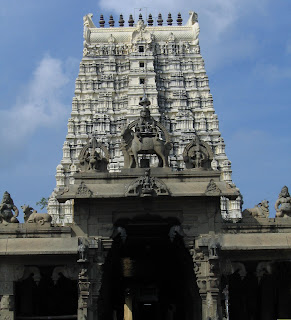The Char Dham Pilgrimage - Traditionally linked to Adi Shankaracharya, the revered Hindu philosopher. The Char Dham pilgrimage holds great significance in Hinduism, involving visits to four sacred sites temples across India. These temples are revered across various Hindu traditions, including Saivism and Vaishnavism, making the Char Dham pilgrimage significant for all Hindus. Each holy site is associated with different yugas and avatars of god Vishnu. Here's a bit more detail on each site:
Badrinath
 |
| Badrinath temple,Uttar Khand .travelogyindia.com |
 |
Badrinath temple,Uttar Khand upload.wikimedia.org
|
Above image: Badrinath is one of the most popular and religious holy towns of the Hindus located in Chamoli district of Uttarkhand inNorth India. Photo credit: .Naresh Balakrishnan
................
Legend: Badrinath gained prominence when Nara-Narayana, an incarnation of Vishnu, performed tapas (meditation) there. The area, rich with berry trees, was originally called Badarikāvaṇa, meaning "forest of berries." Legend says a large berry tree protected Nara-Narayana from the elements, and some believe Lakshmi transformed into this tree to shield Narayana. Hence, the name Badrinath, or "lord of the berry forest," was given to the place in honor of his penance.
Temple Location: The Badrinath Temple is on the banks of the Alaknanda River in Chamoli district, Uttarakhand.
Rameswaram
 |
Rameswaram temple, TN upload.wikimedia.org
|
Above image: Rameswaram temple, TN - the East Gopuram, coastal area SE India, close to Sri Lanka. Photo vinayarajvr
.......
Legend: In the Treta Yuga, Rama installed a lingam at Rameswaram and worshipped it to atone for killing Ravana, a devotee of Shiva. It is believed that Rama's footprints are found at this site.
Significance: Rameswaram is a major pilgrimage site associated with Lord Shiva and is one of the Char Dhams in Hinduism.
Dwarka
 |
The Dwarakadheesh temple upload.wikimedia.org
|
Above image: The Dwarakadheesh temple (Dwarakadhish temple/Dwarkadhish temple) at Dwarka, West Coast. Gujarat, India..
......Legend: Dwarka,established in the Dvapara Yuga.
lord Krishna made it his residence.Laterit became an important center of Krishna's life and activities. Significance: Dwarka in Gujarat, is one of the Char Dhams and a key pilgrimage site for devotees of Krishna.
Puri
 |
| Puri jagannath temple. Odisha upload.wikimedia.org |
Above image: Shri Jagannatha Mandira Puri, India Shri Purushottama Kshetra Puri Shri Kshetra Jagannatha Dham. East Coast Photo credit: credit- Amlan Biswal.
Legend: In Puri, Vishnu is worshipped as Jagannath, an avatar specific to the current epoch, Kali Yuga. The Jagannath Temple is a major pilgrimage destination, especially known for the annual Rath Yatra festival.
Significance: Puri in Odisha, is one of the Char Dhams and holds great spiritual importance in Hinduism.
Adi Shankara and the Four Maṭhas Organization: Adi Shankara of Kalady (Kerala), an 8th-century Hindu philosopher, established four maṭhas (monastic centers) corresponding to the Char Dham sites to promote and preserve the teachings of Advaita Vedanta. Dwarka (West): Govardhan Maṭh. Puri (East): Govardhan Peetham Sringeri ( Karnataka,South): Sringeri Sharada Peetham. Badrinath (North): Jyotirmath or Joshimath
These temples are revered across various Hindu traditions, including Saivism and Vaishnavism, making the Char Dham pilgrimage significant for all Hindus, regardless of their specific spiritual orientation.These sites and institutions form the spiritual backbone of Hindu pilgrimage traditions, each representing a significant aspect of the religion's rich history and mythology.
.bmp) |
| Char dham routes across India. pilgrimaide.com India |
Historical and Cultural Context Historical Tradition: For centuries, devout Hindus have undertaken the arduous pilgrimage to these sites, which was historically fraught with difficulties such as lack of lodging, long travel on foot or by carts, and the threat of robberies. Despite these challenges, the pilgrimage was an important religious undertaking. Roadside Inns: During the reign of the Thanjavur Maratha Bhonsle dynasty (1745-1837 CE), several roadside inns (known as chatrams or choultries) were established from Mayiladuthurai to Rameswaram to aid pilgrims. These inns were donated to the Ramanatha Swamy temple, Rameswaram for their maintenance. Unfortunately, many of these have fallen into disrepair due to negligence and mismanagement by the Tamil Nadu government's Hindu Religious and Charitable Endowments (HR & CE) department.
Pilgrimage Practices - Traditional Route: Traditionally, the pilgrimage begins at Puri in the East, proceeds in a clockwise direction (typical of Hindu temple circumambulation), and concludes at Varanasi (Kasi Visvanathar temple). The journey involves performing Tharpanam (a ritual to honor departed ancestors) after a dip in the Ganges, guided by Pandits (priests) well-versed in the specified mantras.
Spiritual Significance - The primary purpose of the Char Dham pilgrimage is to attain salvation (moksha), aiming to escape the cycle of rebirth and achieve eternal presence in the divine realm.
Preservation and Challenges Cultural Heritage - The pilgrimage's long-standing tradition and its association with significant historical figures like Adi Shankaracharya underscore its cultural heritage. Efforts to preserve and maintain the associated infrastructure, such as the roadside inns and temple properties, are crucial for continuing this sacred journey for future generations.
Conclusion
The Char Dham pilgrimage, encompassing the holy sites of Badrinath, Puri, Dwarka, and Rameswaram, represents a profound spiritual journey for Hindus. Despite historical challenges, the pilgrimage continues to be a cherished tradition, with its purpose rooted in seeking salvation and honoring ancient customs. Preservation efforts for the supporting infrastructure and sacred sites are essential to ensure that this significant religious practice endures.
https://en.wikipedia.org/wiki/Ramanathaswamy_Temple
https://en.wikipedia.org/wiki/Char_Dham
https://www.mapsofindia.com/maps/india/char-dham.html




.bmp)










